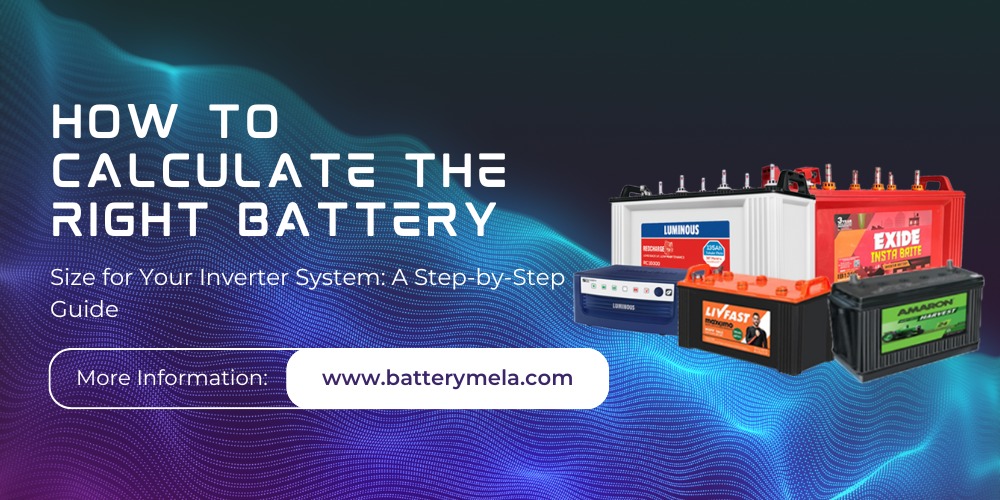No products in the cart.

Battery Size Calculator for Your Inverter System: A Step-by-Step Guide
Introduction:
Selecting the perfect battery size for your inverter system is important for guaranteeing an effective and reliable power supply. A small battery may leave you in the dark during power outages, while an oversized one can be a waste of money. To help you find the perfect match, here’s a step-by-step guide to calculate battery size based on your power needs and inverter specifications.
Step 1: Determine Your Power Requirements
1.1. Calculate Your Daily Power Consumption
Start by assessing your daily power consumption which helps to calculate battery size for inverter. Make a list of all the appliances and devices you want to run on your inverter system. For each item, note the power rating (in watts) and how long you use it each day.
Example:
LED Light Bulb: 10 watts, used for 5 hours/day
Refrigerator: 150 watts, used for 24 hours/day
Television: 100 watts, used for 3 hours/day
To find the daily consumption for each device, use the formula:
Daily Consumption (Wh)=Power (W)×Usage Time (hours)
LED Light Bulb: 10 W×5 hours=50 Wh
Refrigerator: 150 W×24 hours=3600 Wh
Television: 100 W×3 hours=300 Wh
Add these values to find your total daily power consumption:
50 Wh+3600 Wh+300 Wh=3950 Wh/day
1.2. Determine the Battery Backup Duration
Decide how long you want the battery to provide power in case of an outage. This is often referred to as the backup duration. Common choices are 2, 4, or 8 hours.
Step 2: Calculate Battery Capacity
2.1. Convert Daily Consumption to Battery Capacity
To ensure your battery can handle your power needs, you need to convert your daily consumption into battery capacity. You’ll use ampere-hours (Ah) for this calculation. First, determine your battery voltage, which is typically 12V, 24V, or 48V.
Use the formula:
Required Battery Capacity (Ah)= Total Daily Consumption (Wh)/ Battery Voltage (V)×Depth of Discharge (DoD)
Depth of Discharge (DoD): This is the percentage of the battery’s total capacity that can be used. For lead-acid batteries, it’s usually around 50%, while lithium-ion batteries can often be discharged up to 80%.
Example:
If you have a 12V battery and use a 50% DoD:
Required Battery Capacity (Ah)= 3950 Wh/ 12 V×0.50
Required Battery Capacity (Ah)=3950/ 6 ≈ 658.33
This means you need a battery (or a combination of batteries) that provides approximately 658 Ah at 12V.
2.2. Adjust for Backup Duration
To accommodate your desired backup duration, multiply the daily consumption by the number of hours you want the battery to last.
For example, if you want 4 hours of backup:
Required Battery Capacity (Ah)=Total Consumption for 4 Hours/ Battery Voltage (V)×Depth of Discharge (DoD)
Example:
If the daily consumption is 3950 Wh and you want 4 hours of backup, first find the consumption for 4 hours:
4-Hour Consumption (Wh)=(3950 Wh/ 24)×4 ≈ 658.33
Required Battery Capacity (Ah)=658.33 Wh/ 12 V×0.50 ≈ 109.72 Ah
Step 3: Choose the Right Battery Type and Configuration
3.1. Select Battery Type
Based on your requirements, choose between lead-acid, gel, or lithium-ion batteries. Lithium-ion batteries are more expensive and offer higher efficiency and longer lifespans.
3.2. Determine Battery Configuration
Fix that how many batteries you require to get the required capacity. Batteries can be connected in series to increase voltage or in parallel to increase capacity. Ensure the configuration matches your inverter system’s specifications.
Example:
If you need 658 Ah at 12V and choose 12V, 200 Ah batteries, you would need:
658 Ah/ 200 Ah per battery ≈ 3.29 batteries
Round up to 4 batteries, but keep in mind that over-sizing can be more efficient in some cases.
Step 4: Verify and Test
4.1. Verify with Manufacturer Recommendations
Always check with your battery and inverter manufacturers for specific recommendations. They can provide insights into ideal configurations and any special requirements.
4.2. Test Your System
Once installed, test your system to ensure it meets your power needs and provides the desired backup duration. Check performance and make adjustments as necessary.
Conclusion
By calculation, you can understand which size battery is required for your inverter which fulfils your power needs. By evaluation, you can ensure a reliable and efficient power backup solution tailored to your specific requirements. If you need further assistance, consult with a professional to fine-tune your setup for optimal performance.
Frequently Asked Questions
Calculating the correct battery size ensures that your inverter system can meet your power needs without leaving you in the dark during outages. An undersized battery may not provide enough backup power, while an oversized battery could be a waste of money and space. Proper sizing helps balance cost, performance, and reliability.
The Depth of Discharge (DoD) is the percentage of a battery’s total capacity that can be safely used. For lead-acid batteries, this is typically around 50%, while lithium-ion batteries can often be discharged up to 80%. A higher DoD means you can use more of the battery’s capacity, which can affect how many ampere-hours (Ah) you need.
Yes, consulting with a professional is recommended. They can provide insights into your specific needs, help with system design, and ensure that all components are compatible and optimized for your setup.
If your power needs change, you may need to adjust your battery size. This could involve adding or replacing batteries or reconfiguring your battery setup. Regularly assess your power consumption and battery performance to ensure your system remains adequate for your needs.
